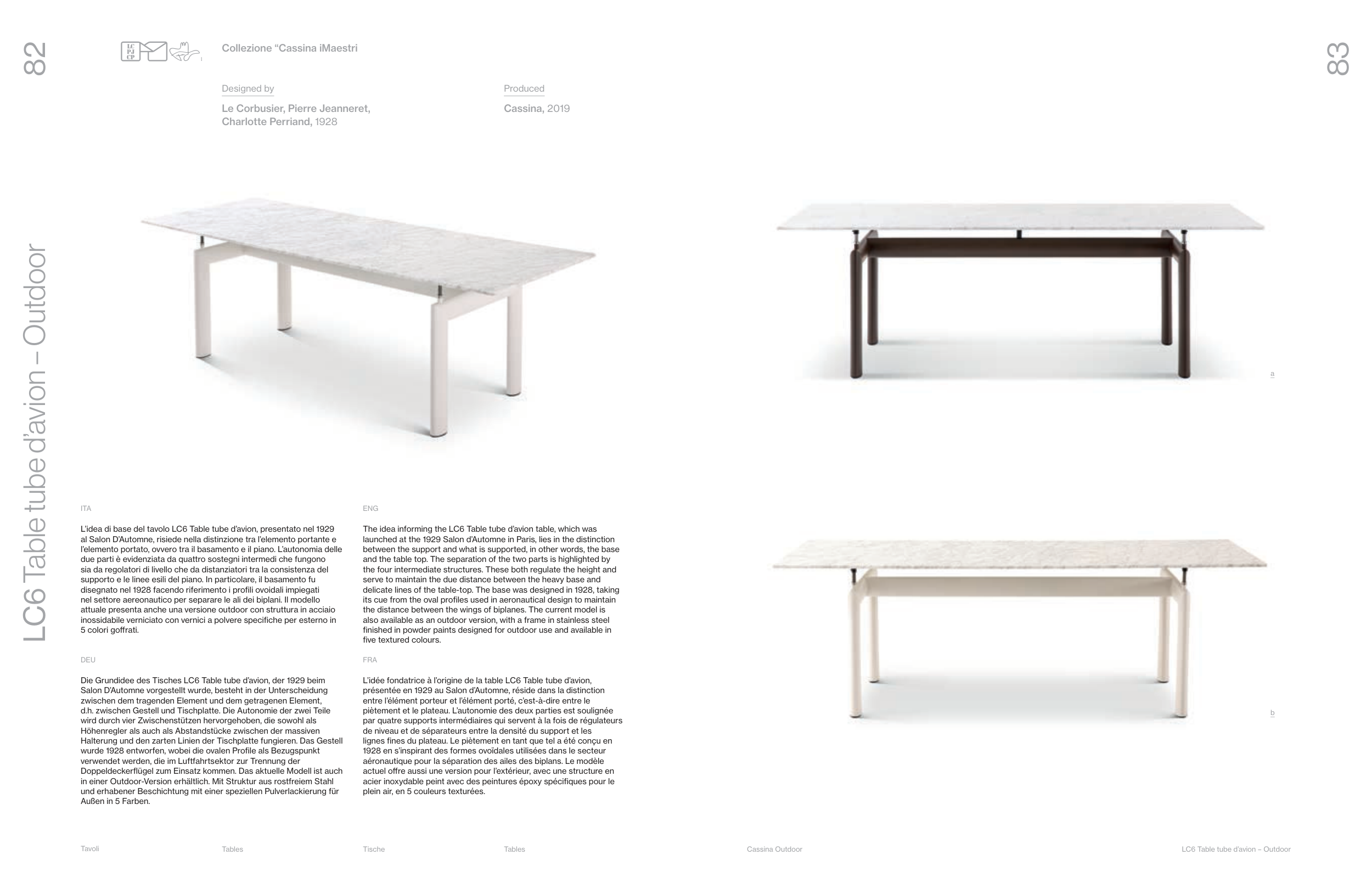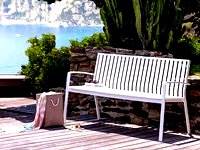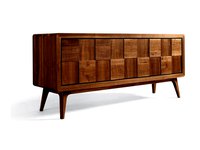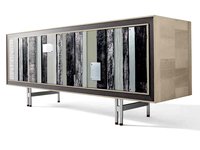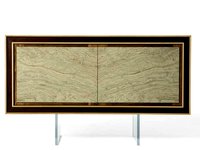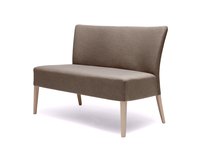LC6 Table tube d’avion – Outdoor
L’idea di base del tavolo LC6 Table tube d’avion, presentato nel 1929
al Salon D’Automne, risiede nella distinzione tra l’elemento portante e
l’elemento portato, ovvero tra il basamento e il piano. L’autonomia delle
due parti è evidenziata da quattro sostegni intermedi che fungono
sia da regolatori di livello che da distanziatori tra la consistenza del
supporto e le linee esili del piano. In particolare, il basamento fu
disegnato nel 1928 facendo riferimento i profili ovoidali impiegati
nel settore aereonautico per separare le ali dei biplani. Il modello
attuale presenta anche una versione outdoor con struttura in acciaio
inossidabile verniciato con vernici a polvere specifiche per esterno in
5 colori goffrati.
The idea informing the LC6 Table tube d’avion table, which was
launched at the 1929 Salon d’Automne in Paris, lies in the distinction
between the support and what is supported, in other words, the base
and the table top. The separation of the two parts is highlighted by
the four intermediate structures. These both regulate the height and
serve to maintain the due distance between the heavy base and
delicate lines of the table-top. The base was designed in 1928, taking
its cue from the oval profiles used in aeronautical design to maintain
the distance between the wings of biplanes. The current model is
also available as an outdoor version, with a frame in stainless steel
finished in powder paints designed for outdoor use and available in
five textured colours.
Die Grundidee des Tisches LC6 Table tube d’avion, der 1929 beim
Salon D’Automne vorgestellt wurde, besteht in der Unterscheidung
zwischen dem tragenden Element und dem getragenen Element,
d.h. zwischen Gestell und Tischplatte. Die Autonomie der zwei Teile
wird durch vier Zwischenstützen hervorgehoben, die sowohl als
Höhenregler als auch als Abstandstücke zwischen der massiven
Halterung und den zarten Linien der Tischplatte fungieren. Das Gestell
wurde 1928 entworfen, wobei die ovalen Profile als Bezugspunkt
verwendet werden, die im Luftfahrtsektor zur Trennung der
Doppeldeckerflügel zum Einsatz kommen. Das aktuelle Modell ist auch
in einer Outdoor-Version erhältlich. Mit Struktur aus rostfreiem Stahl
und erhabener Beschichtung mit einer speziellen Pulverlackierung für
Außen in 5 Farben.
L’idée fondatrice à l’origine de la table LC6 Table tube d’avion,
présentée en 1929 au Salon d’Automne, réside dans la distinction
entre l’élément porteur et l’élément porté, c’est-à-dire entre le
piètement et le plateau. L’autonomie des deux parties est soulignée
par quatre supports intermédiaires qui servent à la fois de régulateurs
de niveau et de séparateurs entre la densité du support et les
lignes fines du plateau. Le piètement en tant que tel a été conçu en
1928 en s’inspirant des formes ovoïdales utilisées dans le secteur
aéronautique pour la séparation des ailes des biplans. Le modèle
actuel offre aussi une version pour l’extérieur, avec une structure en
acier inoxydable peint avec des peintures époxy spécifiques pour le
plein air, en 5 couleurs texturées.
ITA
ENG
DEU
FRA
LC1 N° ____________
LC2 N° ____________
LC3 N° ____________
LC4 N° ____________
LC5 N° ____________
LC6 N° ____________
LC7 N° ____________
LC8 N° ____________
LC9 N° ____________
LC10–P N° ____________
LC11–P N° ____________
LC12 N° ____________
LC14 N° ____________
LC15 N° ____________
LC16 N° ____________
LC17 N° ____________
LC20 N°
____________
Designed by
Le Corbusier, Pierre Jeanneret,
Charlotte Perriand, 1928
Produced
Cassina, 2019
Collezione “Cassina iMaestri
b
a
83
82
LC6 Table tube d’avion – Outdoor
Cassina Outdoor
Tavoli
Tables
Tische
Tables


